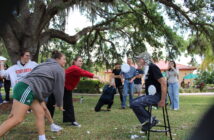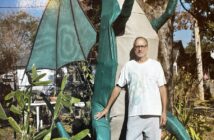By Nicholas Santos, Staff Writer
Saint Edward Hall, which is currently the main office space for many faculty and staff members, began its construction in 1926. However, at this time, the hall was not meant to be the office space that it is today; rather, it was to be designed as a dormitory – the first ever at the school – for students. It was completed by the Christmas of that year and cost around $250,000 to complete. Each of the offices used to be living spaces for students, and many offices were once used for other purposes; for example, one office may have been used as a shower, and another as a reception room. A library was also once stationed at what is now known as Trane Stop. In 1940, loudspeakers were placed above the building and were used to broadcast the new campus radio station WLEO.The first time you ever set foot on the University’s main campus, you were probably awestruck by the overall beauty of it; behind all of this, however, the history of the campus remained a mystery to you, the answers lying in wait in the buildings that populate the campus. What did all of these buildings represent? Where did they come from? This article takes a look at several buildings currently and previously on campus and explores some of their origins and histories.
The Stephen Herrmann Mail Center is named after President Stephen Herrmann, the second president of the University. President Herrmann was known mostly for his desire to support his community. Our Community Service Days are in honor of him. Currently, the mail center sends out over 250,000 pieces of mail and receives over 100,000 pieces of mail each year. It was originally called “The University Mailroom.” For more information on the upbringing of Community Service Day and two other interesting pieces of the University’s history, be sure to look out for the upcoming article “The Origins of Three SLU Features.”
In 1951, construction on a classroom – a project which cost over $208,000 – had started. In 1954, the building was completed, and was named in honor of retired Abbot Francis Sadlier. This building would become known as Saint Francis Hall. This building houses offices for faculty and staff, including the current President of the University.
Father Vincent Crawford, in 1961, contributed to the community beyond his years as a member of the school’s faculty by giving the campus a gift: the funding of a new building that would eventually become Crawford Hall. The building itself was not named after Father Crawford, but was named after his grandfather, Senator George White Crawford, a four-term senator and Civil War veteran. Renovated in 2000, the building had been used as an academic space until its destruction earlier this year. Soon to be in its place is the currently unnamed “Academic Building.” This new building is planned to be completed by the fall semester of next year; however, the quick progress in its development may cause it to be completed much earlier.
In 1962, a construction boom had started; the William P. McDonald Student Center, which is currently known as the Student Activities Building, was created at a cost of $500,000, and, by the end of the next nine year period, three dormitories, two classroom buildings, a science hall, and an activities complex would be created. A cafeteria was also created.
The Julia Deal Lewis Hall of Science, and Selby Auditorium inside of it, was built in 1967. Julia Deal Lewis, along with members of her family – whom the building is named after – were advocates for Catholic education and, being optimistic for the project, provided many grants to help fund the building. The William and Marie Selby Foundation of Sarasota also contributed to the project, leading to naming of Selby Auditorium.
The Marion-Bowman Activities Center, which was named in honor of Father Marion Bowman, OSB, was completed and opened in 1970. Father Bowman, who became the varsity coach and athletic director in 1932, was instrumental in the athletic success of Saint Leo’s sports teams during the 1930s and 1940s. The building itself was notable for having working air conditioning.
The Dome, which used to be used as an art studio and classroom space, was created in 1971, and was one of the most inexpensive projects the University ever completed, costing around $7,500 to build. Before its completion, The Dome’s development was put on hiatus for almost 15 years due to the amount of financial troubles the University was facing at the time. The Dome was taken down in 2006 and was located near the Thomas B. Southard Baseball Stadium.
The Daniel A. Cannon Memorial Library had begun its development in 1986. The project was possible primarily because of Dr. Elizabeth Tousey Cannon, who helped substantially to fund the project in honor of her late husband, Daniel A. Cannon. The building itself cost over $1.9 million to complete.





